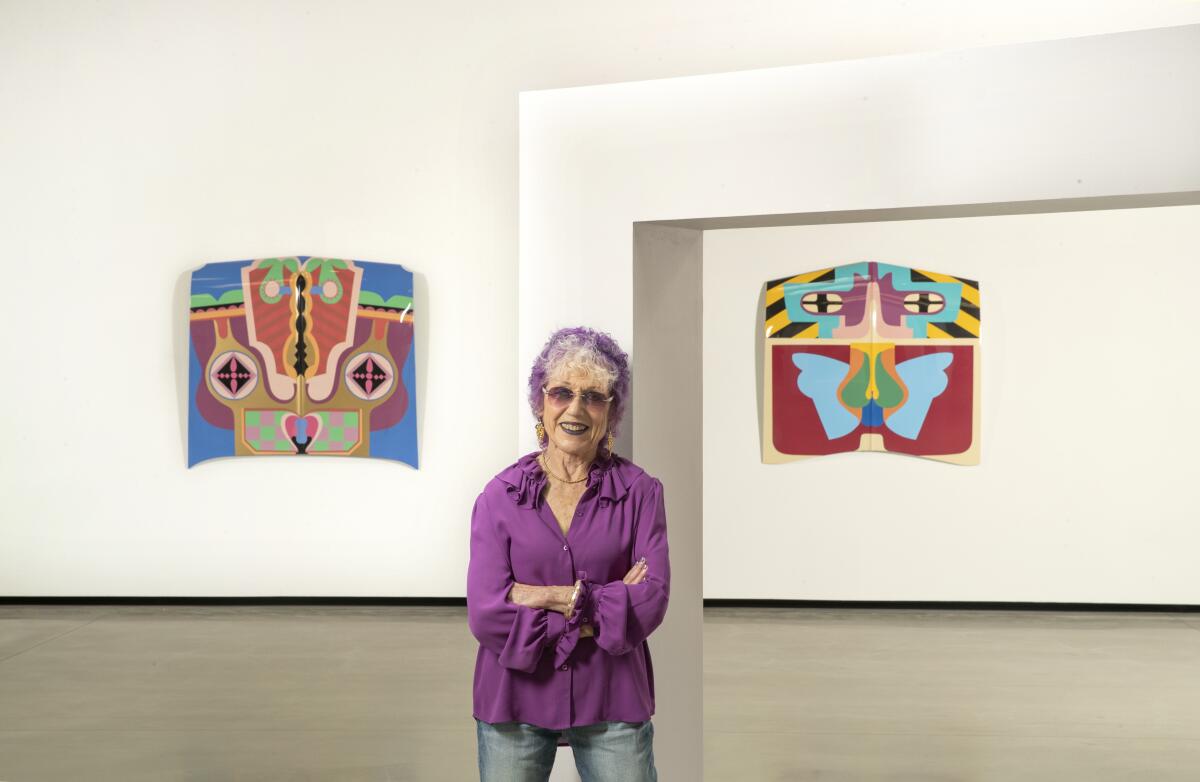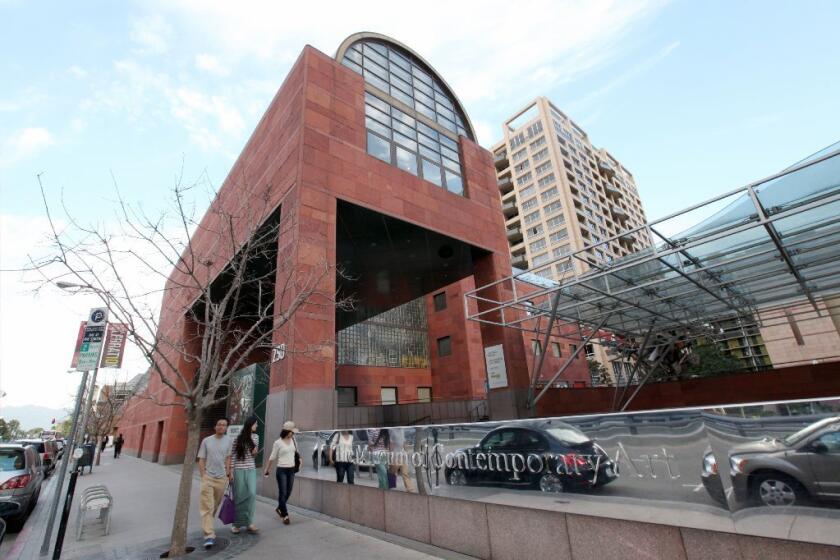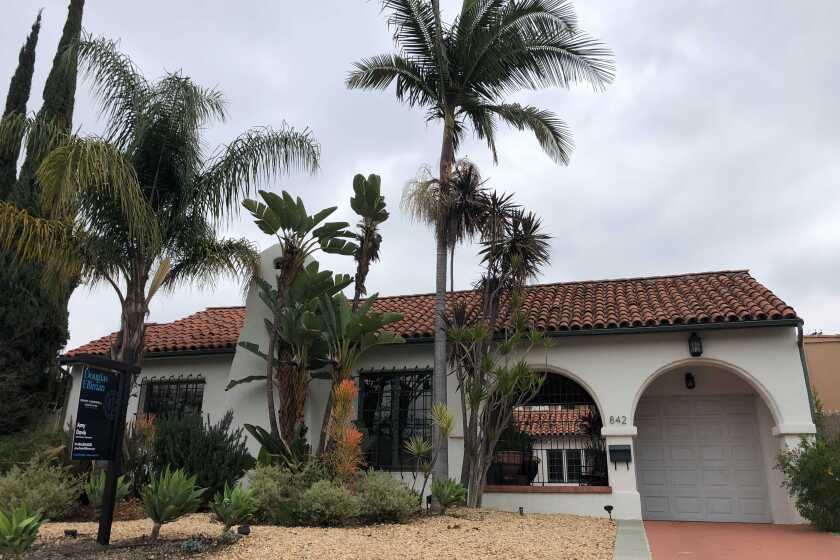Judy Chicago on her Desert X smoke sculpture and feminizing land art

- Share via
The Desert X biennial staging site-specific, sometimes monumental artworks across the Coachella Valley announced its project lineup this week, and a standout among the 13 artists is Judy Chicago.
The 81-year-old artist, who lives in New Mexico but has ties to Los Angeles dating to the 1950s, has long been injecting the feminine into male-dominated land art. Colored smoke in her fireworks pieces, which she’s been producing since the late 1960s, is meant to soften or “feminize” the surrounding landscape. Her new work for Desert X, which opens March 12, is very much an extension of this.
Chicago will create one of her smoke sculptures for the exhibition “Living Smoke: A Tribute to the Living Desert.” The ephemeral work is a collaboration with Chicago’s longtime partner on “pyrotechnic performances,” Chris Souza of Pyro Spectaculars. It will take place one time only, on April 9, but it will be livestreamed on social media. As it swirls and rises over 1,200 acres in the foothills of Eisenhower Mountain at the Living Desert Zoo and Gardens, the brightly colored smoke will highlight the natural beauty of the landscape.
Other artists in the Desert X lineup include Oscar Murillo, Christopher Myers and Kim Stringfellow. We chatted with Chicago about her new piece, the state of land art and the controversies facing Desert X in this edited conversation.
How does this new work connect to your earlier fireworks pieces?
This is kind of a homecoming because I started out in the desert in the late ’60s and early ’70s when it was paradise in Southern California. My friends and I would all go out to a site in the desert or the beach in Santa Barbara, and we’d do a piece and leave no trace except for photographs. This was in stark contrast to my male colleagues [such as Michael Heizer and James Turrell] who were digging up and bulldozing the earth, the land art titans. We’ve all become much more conscious of our relationship to the earth. But I was conscious of it early on.
It is only recently that my “Atmospheres” [series] and smoke sculptures have begun to be understood as a counterpoint to the masculine approach to land art. I used to say with my “Atmospheres” that my intention was to soften and feminize the environment. In the last few years, people have suddenly kind of discovered what I started doing then, which has been very gratifying, and I’ve had the opportunity to build on what I did then. “Living Smoke: A Tribute to the Living Desert” is definitely intended to express my reverence for the land and my efforts to change the paths we’re on. You can understand why I would want to work at the Living Desert, and with the Living Desert. This is their 50th anniversary, and my values as an artist align very closely with theirs, which is the protection of the environment, wildlife and the habitat.
“I thought it would be a perfect show to have at Oscar time,” the gleefully perverse filmmaker says of his gallery exhibition, ‘Hollywood’s Greatest Hits.’
What will the smoke sculpture look like?
I’m literally mixing color in the air. One way readers will be able to understand this project is to go to either the Apple or Google app store and type in “Judy Chicago Rainbow AR,” and they’ll find a free downloadable app which will give them the opportunity to experience a small AR smoke sculpture in their own environment. Imagine the same thing happening in 1,200 acres of desert in the sky, and coming up from the ground, you will have an idea of what the piece will look like. It will unfold over six to 10 minutes, and there will be successive introductions of various combinations of colored smokes. [It’s] merging my desire to infuse color and beauty into the landscape with the natural forces of the environment: wind, light, hopefully no rain!
Desert X has received pushback, in previous iterations, for artworks intruding on the local landscape. Is that something you’re mindful of?
Because it’s such a big site — 1,200 acres — we could probably have thousands of people there. But we’re not doing that because of COVID and also because it would be disruptive to the wildlife. We’re going to have a limited live audience, but we’re livestreaming it all over the world. It’ll be socially distanced, wearing masks. We’re being very cautious.
I and my pyro-collaborator, we like the old-fashioned method of lighting fireworks by hand with black match, so you hear this [screeching] noise. But we’re not doing that because that noise would be disruptive to the wildlife. It’ll be electronic, so there will be no sound.
At the Museum of Contemporary Art in L.A., Klaus Biesenbach will shift to artistic director and will be joined by a new executive director.
And what am I asking people to do, both the people who are there and the people who will watch it? I’m asking them to look at the environment. Just look at the natural environment. Be there. Look at it. Watch beauty unfold in it. And hopefully that will help transform human consciousness so that we change course and become stewards of the incredible landscape that gives us life instead of destroying it.
How is the piece, with all that smoke, environmentally friendly?
The colored smoke is environmentally friendly and nontoxic. The Living Desert would not allow me to do something that would be damaging to the landscape or the animals. The smoke is only colored pigment. Let’s say you are an artist and you grind your own pigment, and you took some of it and threw it in the air — it’s just a lot of it.
Desert X explores the environment of the Coachella Valley and the people who reside there. How is your piece in dialogue with the Cahuilla people?
Through connecting with the traditions that are meaningful to me, like the traditions of reverence for the land that are evidenced by Indigenous people. And by sharing the work via livestream through the Coachella Valley and around the world. And by doing educational programs with children thanks to Jordan [D. Schnitzer, whose foundation is sponsoring the piece].
Do you think land art is becoming more egalitarian? Women are making new and interesting work in this area, including Nancy Baker Cahill in Desert X’s 2019 exhibition.
There are definitely women working in land art now that bring a different sensibility, but not all. It has to do with the level of support that the major male land artists got, like [Walter De Maria’s] “The Lightning Field,” [commissioned by] Dia Art Foundation. Major funding. Women artists have not had that level of support to be able to mount a feminine equivalent to what the guys have been able to do. So it’s difficult to answer your question. Because of the historic lack of support, we haven’t been able to see, at the same scale, what women are bringing to land art. There may be a lot of women doing it, but what they do or have done is not as visible to us because they have not had the resources to do it at the same scale as James Turrell or Michael Heizer.
“Desert X AlUla” stirred much criticism. The exhibition, in early 2020, was funded by the government of Saudi Arabia and took place in that country. Did you have any reservations about participating this year?
I actually didn’t know that much about Desert X, to be honest. Jeffrey [Deitch] told me about the controversy around Saudi Arabia.
I would say that one could probably fault almost every biennial in the world for some reason or another because most of them work out of a particular paradigm and set of values. So all I can do is try to bring my values into that setting and hope that it makes a difference.
Look at all the situations that are being protested: Leon Black [the chairman of the board of trustees] at MoMA had contact with Jeffrey Epstein, [former Vice Chairman Warren] Kanders at the Whitney and tear gas. Tell me an institution that doesn’t have tawdry connections. What I’ve done through my whole career, is struggle to maintain my own vision, pursue my own vision and try to express my values through the art I make.
You wrote a book that comes out later this year, “The Flowering: The Autobiography of Judy Chicago.” With all that revisiting of the past, did you have any lightbulb moments?
It gave me the opportunity to look back on a lot of my experiences — and of course everyone could get a PhD in hindsight — but I see things now that I didn’t see at the time. Like: My painting teachers at UCLA hated my imagery, hated my color, made me feel like there was something wrong with it and with me. Now I understand they hated my color because it was feminine. I like ivories, and pinks, and turquoise and purple. I tried to suppress, for the first decade of my art making, anything that would mark me as a woman, because to be a woman in the L.A. art scene was not desirable. However, that didn’t work for me. I made a radical change in my work and went to Fresno [State] to start the first feminist art program, and I set out to try and create a feminist art practice.
Now, when I think about my swirling color in the air [in the early smoke pieces] at the end of the ’60s, I see it as a gesture of liberation releasing myself and my creative energies from the constraints of male minimalism. But at the time, I didn’t understand that.
First, LACMA sold its $6.6-million director’s home and bought Govan another for $2.2 million. Less than a year later the new home is on the market.
More to Read
The biggest entertainment stories
Get our big stories about Hollywood, film, television, music, arts, culture and more right in your inbox as soon as they publish.
You may occasionally receive promotional content from the Los Angeles Times.













